
(Click on any image below for a larger version)
Tuesday, January 23: Paulet Island
The next morning I awoke to see numerous ice floes and bergs moving past the stateroom window. During the night we had negotiated the Antarctic Sound and entered the Weddell Sea to the east of the Antarctic Peninsula.
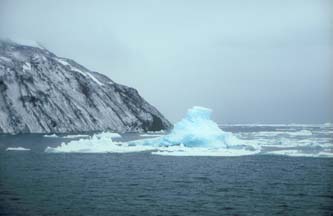 The Hanseatic dropped anchor a
short distance offshore of Paulet Island. It is a small
cone-shaped island, the product of volcanic eruptions. The waters
around the island were thick with icebergs and floes.
The Hanseatic dropped anchor a
short distance offshore of Paulet Island. It is a small
cone-shaped island, the product of volcanic eruptions. The waters
around the island were thick with icebergs and floes.
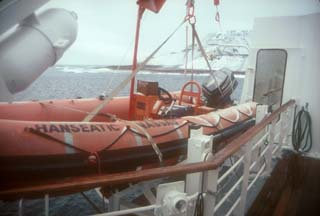 A light snow was falling. Snow was
accumulating on the exposed surfaces of the ship.
A light snow was falling. Snow was
accumulating on the exposed surfaces of the ship.
The Zodiac driver steered around several icebergs on the way to our landing on Paulet Island. Most of them were grounded and did not move with the water currents. The icebergs had been eroded at the waterline, leaving wide overhangs on all sides of the bergs.
We landed on a shore of large, smooth cobbles and boulders.
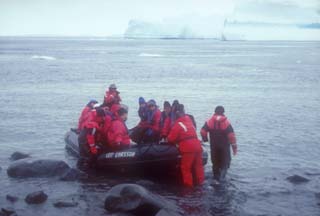 Geoff Green briefed the occupants of each Zodiac about what there
was to see and where to go on the island.
Geoff Green briefed the occupants of each Zodiac about what there
was to see and where to go on the island.
Once out of the Zodiac I was able to walk to the beach across a series of rounded stones sticking up out of the water.
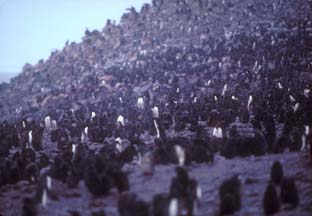 Paulet Island is the site of an Adelie Penguin rookery.
Paulet Island is the site of an Adelie Penguin rookery.
 Adelie Penguins are the ones that you see most commonly at ocean
theme parks such as Sea World. They have the classic black on the
back and white on the front penguin markings. Their heads are
completely black, with no white markings.
Adelie Penguins are the ones that you see most commonly at ocean
theme parks such as Sea World. They have the classic black on the
back and white on the front penguin markings. Their heads are
completely black, with no white markings.
Background information about the Adelie Penguin.
 Large chunks of ice were scattered across the stony beach,
indicating that we had arrived at low tide.
Large chunks of ice were scattered across the stony beach,
indicating that we had arrived at low tide.
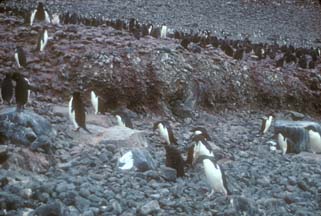 There was a steep wave cut above the beach. The rocks above the
beach hadn't been eroded into smooth round cobbles.
There was a steep wave cut above the beach. The rocks above the
beach hadn't been eroded into smooth round cobbles.
David Fletcher had been assigned to help people clamber up the uneven slope. David was one of the biggest members of the ship's staff, and it seemed that he was always assigned to the most treacherous parts of the trail.
 Just after we landed, a large ice
floe carrying many Adelie Penguins drifted slowly past the shore.
Just after we landed, a large ice
floe carrying many Adelie Penguins drifted slowly past the shore.
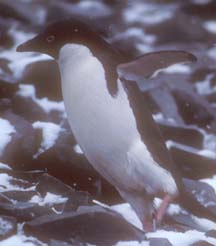 The trail ascended a tricky slope of loose, irregular stones that
were covered with a thick lubricating layer of guano to get to
the rookery.
The trail ascended a tricky slope of loose, irregular stones that
were covered with a thick lubricating layer of guano to get to
the rookery.
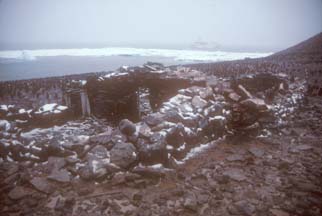 The lower walls of an old stone hut
are slowly falling to pieces on a flat area above the beach. It
is the remains of an expedition hut that was constructed by the
Otto Nordenskjold expedition in 1903 after their ship, the
Antarctic, was crushed by sea ice. The hut was roofed with the
Antarctic's boats, planks, and canvas. The Antarctic Sound is
named after Nordenskjold's ship.
The lower walls of an old stone hut
are slowly falling to pieces on a flat area above the beach. It
is the remains of an expedition hut that was constructed by the
Otto Nordenskjold expedition in 1903 after their ship, the
Antarctic, was crushed by sea ice. The hut was roofed with the
Antarctic's boats, planks, and canvas. The Antarctic Sound is
named after Nordenskjold's ship.
The Antarctic Philately web site has a biography about Otto Nordenskjold.
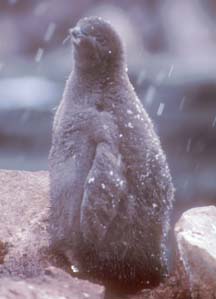 Adelie Penguin chicks are gray all over.
Adelie Penguin chicks are gray all over.
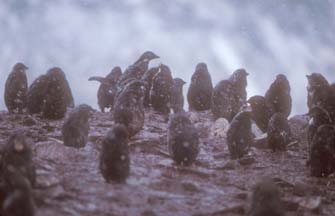 There was a lot more room to move around on
Paulet Island, both for us and for the penguins.
There was a lot more room to move around on
Paulet Island, both for us and for the penguins.
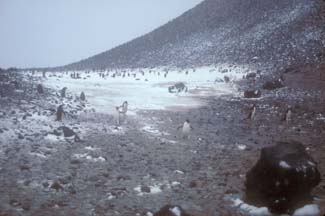 The path led us past a flat snowy patch to the edge of a small
crater with a fresh water lake in it.
The path led us past a flat snowy patch to the edge of a small
crater with a fresh water lake in it.
 Half
of the lake was coated with ice.
Half
of the lake was coated with ice.
 Big fluffy snowflakes began to fall on our
group. The rocks quickly acquired a thick layer of snow on their
upwind faces. So did the penguin chicks. One of the chicks was
plucking snowflakes out of the air with little stabbing motions
of its head.
Big fluffy snowflakes began to fall on our
group. The rocks quickly acquired a thick layer of snow on their
upwind faces. So did the penguin chicks. One of the chicks was
plucking snowflakes out of the air with little stabbing motions
of its head.
 This homely chick was partway through molting.
This homely chick was partway through molting.
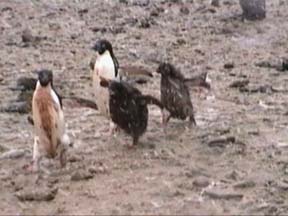 The feeding ritual incorporated an additional
twist that we hadn't observed at the other rookeries. Many of the
Adelie Penguins brood two chicks at a time. Once a pair of chicks
responded to an adult's call, the adult would start running away
from the chicks.
The feeding ritual incorporated an additional
twist that we hadn't observed at the other rookeries. Many of the
Adelie Penguins brood two chicks at a time. Once a pair of chicks
responded to an adult's call, the adult would start running away
from the chicks.
 Hear an Adelie Penguin chick chasing an adult. If you listen closely, you can hear the patter of the penguins' feet as they run past.
Hear an Adelie Penguin chick chasing an adult. If you listen closely, you can hear the patter of the penguins' feet as they run past.
 The chicks then had to chase the adult through
the rookery, pleading plaintively the whole way, until it decided
that they were indeed its own chicks.
The chicks then had to chase the adult through
the rookery, pleading plaintively the whole way, until it decided
that they were indeed its own chicks.
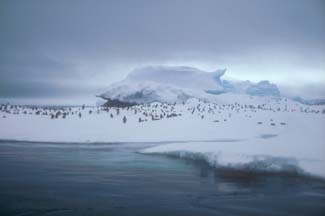 The Zodiac driver took us for a cruise around the nearby ice
floes to photograph the penguins on them. A larger fraction of
the penguins were resting on their bellies on the clean ice than
had been on the guano-covered rocks onshore. They often propelled
themselves along with their feet, tobogganing on their bellies.
The Zodiac driver took us for a cruise around the nearby ice
floes to photograph the penguins on them. A larger fraction of
the penguins were resting on their bellies on the clean ice than
had been on the guano-covered rocks onshore. They often propelled
themselves along with their feet, tobogganing on their bellies.
Flocks of penguins swam in the water around the Zodiac. They leaped out of the water like dolphins just a few feet from the bow of the boat. Sometimes several of the penguins would leap out of the water at the same time.
As we slowly drifted past a snow-covered blue iceberg, it calved several large chunks of ice from below the waterline. Without any warning, they bobbed to the surface alongside the Zodiac. The first and largest of them was just about as big as the Zodiac. It could have seriously disturbed the boat if it had come up directly underneath us.
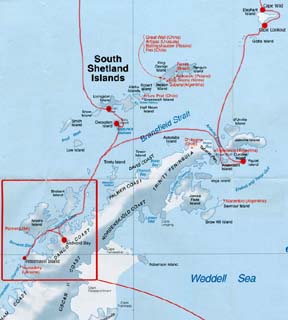 Map of the Antarctic Peninsula.
Map of the Antarctic Peninsula.
 Table of
Contents
Table of
Contents Send a message to Brian.